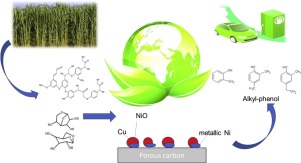当前位置:
X-MOL 学术
›
J. Anal. Appl. Pyrol.
›
论文详情
Our official English website, www.x-mol.net, welcomes your feedback! (Note: you will need to create a separate account there.)
Catalytic pyrolysis of Napier grass with nickel-copper core-shell bi-functional catalyst
Journal of Analytical and Applied Pyrolysis ( IF 6 ) Pub Date : 2020-01-01 , DOI: 10.1016/j.jaap.2019.104745 Sang Dinh Ngo , Thi Tuong Vi Tran , Suwadee Kongparakul , Prasert Reubroycharoen , Pinit Kidkhuntod , Narong Chanlek , Jing Wang , Guoqing Guan , Chanatip Samart
Journal of Analytical and Applied Pyrolysis ( IF 6 ) Pub Date : 2020-01-01 , DOI: 10.1016/j.jaap.2019.104745 Sang Dinh Ngo , Thi Tuong Vi Tran , Suwadee Kongparakul , Prasert Reubroycharoen , Pinit Kidkhuntod , Narong Chanlek , Jing Wang , Guoqing Guan , Chanatip Samart

|
Abstract Nickel-copper (Ni-Cu) core-shell catalysts supported on phosphorus-modified carbon microspheres (mCMs) were prepared at three Ni/Cu mass ratios, and applied to the catalytic pyrolysis of Napier grass (Pennisetum purpureum) under atmospheric pressure. The catalytic pyrolysis was carried out inside a custom-built one-shot two-stage fixed-bed reactor. The catalyst structure was confirmed by X-ray photoelectron spectroscopy and X-ray absorption spectroscopy. Remarkably, the Ni-Cu/mCM catalysts increased the produced alkyl-phenols by up to fourfold, and these products are an excellent gasoline blend stock due to their high blending octane number. At the same time, the mass of undesired compounds in the bio-oil including alcohols, ketones, and furan were markedly decreased compared to the case without a catalyst. The oxygen content of the bio-oil was reduced by up to 24 % compared to the non-catalytic case. The hydrogen/carbon and oxygen/carbon molar ratios were also improved after all catalytic treatments. Finally, a reaction mechanism was proposed, including the pathways of oxygen removal through dehydration, decarbonylation, and dealkoxylation. The presence of NiO in the Ni-Cu/mCM catalyst promoted the alkylation reaction to yield more alkyl-phenols.
中文翻译:

镍铜核壳双功能催化剂催化热解纳皮尔草
摘要 以三种 Ni/Cu 质量比制备了负载在磷改性碳微球 (mCMs) 上的镍铜 (Ni-Cu) 核壳催化剂,并将其应用于常压下 Napier 草 (Pennisetum purpureum) 的催化热解。催化热解在定制的一次性两级固定床反应器内进行。通过X射线光电子能谱和X射线吸收光谱证实了催化剂结构。值得注意的是,Ni-Cu/mCM 催化剂使产生的烷基苯酚增加了四倍,并且这些产品由于其高混合辛烷值是一种极好的汽油混合原料。同时,与没有催化剂的情况相比,生物油中不想要的化合物(包括醇、酮和呋喃)的质量显着减少。与非催化情况相比,生物油的氧含量降低了 24%。在所有催化处理之后,氢/碳和氧/碳摩尔比也得到改善。最后,提出了反应机理,包括通过脱水、脱羰和脱烷氧基脱氧的途径。Ni-Cu/mCM 催化剂中 NiO 的存在促进了烷基化反应以产生更多的烷基酚。
更新日期:2020-01-01
中文翻译:

镍铜核壳双功能催化剂催化热解纳皮尔草
摘要 以三种 Ni/Cu 质量比制备了负载在磷改性碳微球 (mCMs) 上的镍铜 (Ni-Cu) 核壳催化剂,并将其应用于常压下 Napier 草 (Pennisetum purpureum) 的催化热解。催化热解在定制的一次性两级固定床反应器内进行。通过X射线光电子能谱和X射线吸收光谱证实了催化剂结构。值得注意的是,Ni-Cu/mCM 催化剂使产生的烷基苯酚增加了四倍,并且这些产品由于其高混合辛烷值是一种极好的汽油混合原料。同时,与没有催化剂的情况相比,生物油中不想要的化合物(包括醇、酮和呋喃)的质量显着减少。与非催化情况相比,生物油的氧含量降低了 24%。在所有催化处理之后,氢/碳和氧/碳摩尔比也得到改善。最后,提出了反应机理,包括通过脱水、脱羰和脱烷氧基脱氧的途径。Ni-Cu/mCM 催化剂中 NiO 的存在促进了烷基化反应以产生更多的烷基酚。


























 京公网安备 11010802027423号
京公网安备 11010802027423号